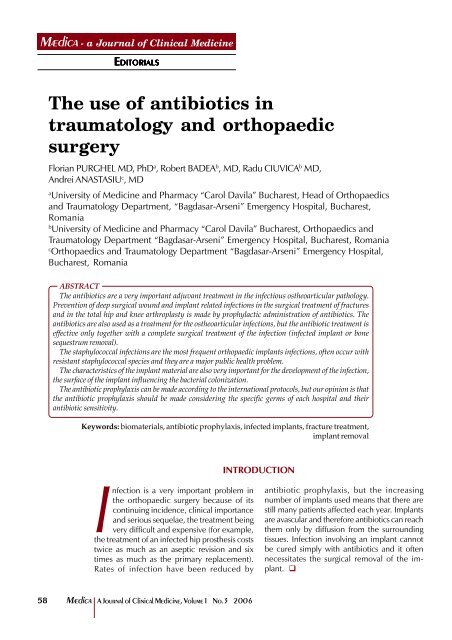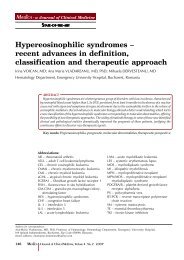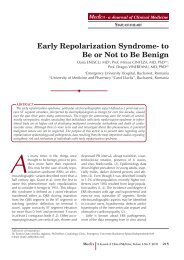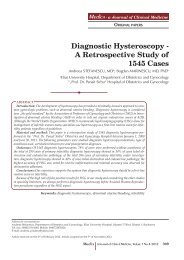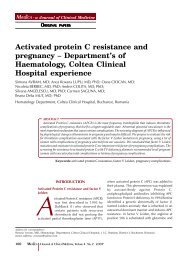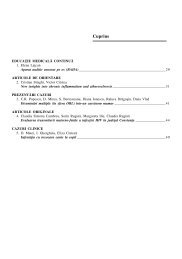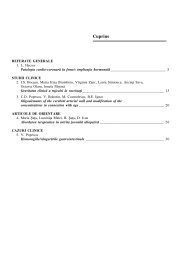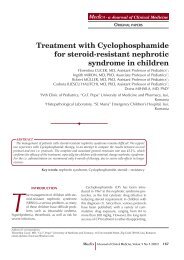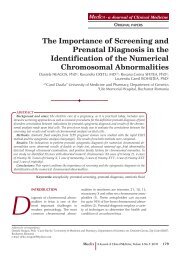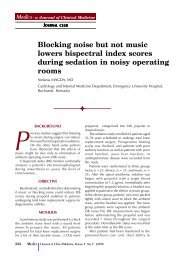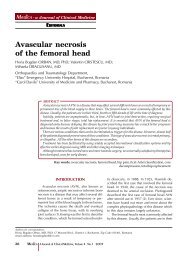The use of antibiotics in traumatology and orthopaedic surgery
The use of antibiotics in traumatology and orthopaedic surgery
The use of antibiotics in traumatology and orthopaedic surgery
Create successful ePaper yourself
Turn your PDF publications into a flip-book with our unique Google optimized e-Paper software.
Mædica - a Journal <strong>of</strong> Cl<strong>in</strong>ical Medic<strong>in</strong>e<br />
58<br />
EDITORIALS<br />
DITORIALS<br />
<strong>The</strong> <strong>use</strong> <strong>of</strong> <strong>antibiotics</strong> <strong>in</strong><br />
<strong>traumatology</strong> <strong>and</strong> <strong>orthopaedic</strong><br />
<strong>surgery</strong><br />
Florian PURGHEL MD, PhD a , Robert BADEA b , MD, Radu CIUVICA b MD,<br />
Andrei ANASTASIU c , MD<br />
aUniversity <strong>of</strong> Medic<strong>in</strong>e <strong>and</strong> Pharmacy “Carol Davila” Bucharest, Head <strong>of</strong> Orthopaedics<br />
<strong>and</strong> Traumatology Department, “Bagdasar-Arseni” Emergency Hospital, Bucharest,<br />
Romania<br />
bUniversity <strong>of</strong> Medic<strong>in</strong>e <strong>and</strong> Pharmacy “Carol Davila” Bucharest, Orthopaedics <strong>and</strong><br />
Traumatology Department “Bagdasar-Arseni” Emergency Hospital, Bucharest, Romania<br />
cOrthopaedics <strong>and</strong> Traumatology Department “Bagdasar-Arseni” Emergency Hospital,<br />
Bucharest, Romania<br />
ABSTRACT<br />
<strong>The</strong> <strong>antibiotics</strong> are a very important adjuvant treatment <strong>in</strong> the <strong>in</strong>fectious ostheoarticular pathology.<br />
Prevention <strong>of</strong> deep surgical wound <strong>and</strong> implant related <strong>in</strong>fections <strong>in</strong> the surgical treatment <strong>of</strong> fractures<br />
<strong>and</strong> <strong>in</strong> the total hip <strong>and</strong> knee arthroplasty is made by prophylactic adm<strong>in</strong>istration <strong>of</strong> <strong>antibiotics</strong>. <strong>The</strong><br />
<strong>antibiotics</strong> are also <strong>use</strong>d as a treatment for the ostheoarticular <strong>in</strong>fections, but the antibiotic treatment is<br />
effective only together with a complete surgical treatment <strong>of</strong> the <strong>in</strong>fection (<strong>in</strong>fected implant or bone<br />
sequestrum removal).<br />
<strong>The</strong> staphylococcal <strong>in</strong>fections are the most frequent <strong>orthopaedic</strong> implants <strong>in</strong>fections, <strong>of</strong>ten occur with<br />
resistant staphylococcal species <strong>and</strong> they are a major public health problem.<br />
<strong>The</strong> characteristics <strong>of</strong> the implant material are also very important for the development <strong>of</strong> the <strong>in</strong>fection,<br />
the surface <strong>of</strong> the implant <strong>in</strong>fluenc<strong>in</strong>g the bacterial colonization.<br />
<strong>The</strong> antibiotic prophylaxis can be made accord<strong>in</strong>g to the <strong>in</strong>ternational protocols, but our op<strong>in</strong>ion is that<br />
the antibiotic prophylaxis should be made consider<strong>in</strong>g the specific germs <strong>of</strong> each hospital <strong>and</strong> their<br />
antibiotic sensitivity.<br />
Keywords: biomaterials, antibiotic prophylaxis, <strong>in</strong>fected implants, fracture treatment,<br />
implant removal<br />
Infection is a very important problem <strong>in</strong><br />
the <strong>orthopaedic</strong> <strong>surgery</strong> beca<strong>use</strong> <strong>of</strong> its<br />
cont<strong>in</strong>u<strong>in</strong>g <strong>in</strong>cidence, cl<strong>in</strong>ical importance<br />
<strong>and</strong> serious sequelae, the treatment be<strong>in</strong>g<br />
very difficult <strong>and</strong> expensive (for example,<br />
the treatment <strong>of</strong> an <strong>in</strong>fected hip prosthesis costs<br />
twice as much as an aseptic revision <strong>and</strong> six<br />
times as much as the primary replacement).<br />
Rates <strong>of</strong> <strong>in</strong>fection have been reduced by<br />
Mædica A Journal <strong>of</strong> Cl<strong>in</strong>ical Medic<strong>in</strong>e, Volume1 No.3 2006<br />
INTRODUCTION<br />
antibiotic prophylaxis, but the <strong>in</strong>creas<strong>in</strong>g<br />
number <strong>of</strong> implants <strong>use</strong>d means that there are<br />
still many patients affected each year. Implants<br />
are avascular <strong>and</strong> therefore <strong>antibiotics</strong> can reach<br />
them only by diffusion from the surround<strong>in</strong>g<br />
tissues. Infection <strong>in</strong>volv<strong>in</strong>g an implant cannot<br />
be cured simply with <strong>antibiotics</strong> <strong>and</strong> it <strong>of</strong>ten<br />
necessitates the surgical removal <strong>of</strong> the implant.<br />
�
STAPHYLOCOCCAL INFECTIONS<br />
Def<strong>in</strong>ition <strong>and</strong> classification<br />
<strong>The</strong> staphilococs are Gram-positive bacteria,<br />
divided <strong>in</strong> 43 species <strong>and</strong> subspecies, which<br />
usually are commensal <strong>and</strong> live on sk<strong>in</strong> <strong>and</strong><br />
mucosae. Staphilococcus can be classified <strong>in</strong><br />
coagulase-positive Staphilococcus (S. aureus)<br />
<strong>and</strong> coagulase-negative Staphilococcus (S.<br />
epidermidis, S. haemolyticus).<br />
Pathogenesis<br />
Studies have most frequently resulted <strong>in</strong><br />
isolation <strong>of</strong> Staphylococcus epidermidis <strong>and</strong><br />
Staphylococcus aureus from <strong>in</strong>fected biomaterial<br />
surfaces.<br />
Staphilococcus aureus produces a large number<br />
<strong>of</strong> enzymes (adhes<strong>in</strong>es, haemolys<strong>in</strong>es) <strong>and</strong><br />
tox<strong>in</strong>s. It becomes resistant to most <strong>of</strong> the<br />
<strong>antibiotics</strong> that were <strong>in</strong>itially active. Almost all<br />
<strong>of</strong> the species produce beta-lactamase (1).<br />
U<br />
A<br />
T<br />
THE UUSE<br />
U OF AANTIBIOTICS<br />
A<br />
IN TTRAUMATOLOGY<br />
T<br />
AND OORTHOPAEDIC<br />
O SSURGERY<br />
S<br />
<strong>The</strong> search for <strong>antibiotics</strong> began <strong>in</strong> the late 1800s, with the grow<strong>in</strong>g acceptance<br />
<strong>of</strong> the germ theory <strong>of</strong> disease, a theory which l<strong>in</strong>ked bacteria <strong>and</strong> other microbes<br />
to the causation <strong>of</strong> a variety <strong>of</strong> diseases.<br />
In 1928, the British scientist Alex<strong>and</strong>er Flem<strong>in</strong>g discovered a substance that he<br />
named penicill<strong>in</strong>, after the Penicillium mold that had produced it, that was able to<br />
destroy a common bacterium, Staphylococcus aureus, associated with sometimes<br />
deadly sk<strong>in</strong> <strong>in</strong>fections. <strong>The</strong> value <strong>of</strong> penicill<strong>in</strong> <strong>in</strong> the treatment <strong>of</strong> orthopedic cases<br />
was first appreciated dur<strong>in</strong>g World War II, <strong>in</strong> the treatment <strong>of</strong> battle casualties. By<br />
1946, the drug had become widespread for cl<strong>in</strong>ical <strong>use</strong>. In the late 1940s the first<br />
penicill<strong>in</strong> resistant stra<strong>in</strong>s were reported, but it was not until the 1970s that antibiotic<br />
resistance was considered to be a real threat. <strong>The</strong> success <strong>of</strong> penicill<strong>in</strong> <strong>in</strong>tensified<br />
searches for new <strong>antibiotics</strong> that could treat other<br />
bacterial diseases, <strong>in</strong>clud<strong>in</strong>g those ca<strong>use</strong>d by now<br />
penicill<strong>in</strong> resistant stra<strong>in</strong>s. One way to combat resistance<br />
was to chemically modify penicill<strong>in</strong>, creat<strong>in</strong>g derivatives<br />
<strong>of</strong> the chemical, such as ampicill<strong>in</strong>, that avoided<br />
enzymatic degradation. Today, numerous penicill<strong>in</strong> derivatives exist. Beca<strong>use</strong> <strong>of</strong> the<br />
large number <strong>of</strong> penicill<strong>in</strong> resistant stra<strong>in</strong>s, ampicill<strong>in</strong> or penicill<strong>in</strong> should be added to<br />
the antibiotic regimen only when there are conditions favor<strong>in</strong>g the development <strong>of</strong><br />
anaerobic <strong>in</strong>fections.<br />
<strong>The</strong> cephalospor<strong>in</strong>s are a class <strong>of</strong> β-lactam <strong>antibiotics</strong>. Cephalospor<strong>in</strong> compounds<br />
were first isolated from cultures <strong>of</strong> Cephalosporium acremonium <strong>in</strong> Italy, <strong>in</strong> 1948,<br />
<strong>and</strong> the first agent (cephalot<strong>in</strong>) was launched <strong>in</strong> 1964. S<strong>in</strong>ce then, they became<br />
one <strong>of</strong> the most <strong>use</strong>d classes <strong>of</strong> <strong>antibiotics</strong> <strong>in</strong> the prevention <strong>and</strong> the treatment <strong>of</strong><br />
<strong>orthopaedic</strong> <strong>in</strong>fections.<br />
Other classes <strong>of</strong> <strong>antibiotics</strong> that are <strong>use</strong>d today <strong>in</strong> the treatment <strong>of</strong> <strong>orthopaedic</strong><br />
<strong>in</strong>fections are the amynoglicosides (gentamic<strong>in</strong>, tobramyc<strong>in</strong>, amikac<strong>in</strong>), the glycopeptide<br />
<strong>antibiotics</strong> (vancomyc<strong>in</strong>) <strong>and</strong> the qu<strong>in</strong>olones (cipr<strong>of</strong>loxac<strong>in</strong>, <strong>of</strong>loxac<strong>in</strong>). �<br />
SHORT HISTORY OF<br />
ANTIBIOTICS USE IN<br />
ORTHOPAEDIC SURGERY<br />
Mædica A Journal <strong>of</strong> Cl<strong>in</strong>ical Medic<strong>in</strong>e, Volume1 No.3 2006 59<br />
O<br />
Staphylococcus epidermidis is frequently<br />
<strong>in</strong>volved when the biomaterial surface is a<br />
polymer. Staphylococcus aureus is <strong>of</strong>ten the<br />
major pathogen <strong>in</strong> biometal, bone <strong>and</strong> jo<strong>in</strong>t<br />
<strong>and</strong> s<strong>of</strong>t tissue <strong>in</strong>fections. Staphylococcus aureus<br />
is the most common pathogen isolated <strong>in</strong> osteomyelitis<br />
when damaged or dead bone acts as<br />
a substratum.<br />
<strong>The</strong> staphylococcal <strong>in</strong>fections <strong>of</strong> the <strong>orthopaedic</strong><br />
implants are a major problem <strong>of</strong> public<br />
health, beca<strong>use</strong> they are chronic, difficult to treat<br />
by surgical <strong>and</strong> non-surgical methods <strong>and</strong> they<br />
have a very high social cost (2).<br />
<strong>The</strong> most frequent ca<strong>use</strong> <strong>of</strong> staphylococcal<br />
<strong>in</strong>fections is the perioperative contam<strong>in</strong>ation,<br />
<strong>and</strong> the germs come from the patient or from<br />
the operat<strong>in</strong>g room. <strong>The</strong>re is a direct relationship<br />
between the number <strong>of</strong> persons <strong>in</strong> the operat<strong>in</strong>g<br />
room <strong>and</strong> the number <strong>of</strong> germs (if there<br />
are 5 persons <strong>in</strong> the operat<strong>in</strong>g room, the concentration<br />
<strong>of</strong> germs is over 30 times higher than<br />
<strong>in</strong> an empty operat<strong>in</strong>g room).<br />
S
THE UUSE<br />
U OF AANTIBIOTICS<br />
A<br />
IN TTRAUMATOLOGY<br />
T<br />
AND OORTHOPAEDIC<br />
O SSURGERY<br />
S<br />
60<br />
U<br />
A<br />
T<br />
O<br />
<strong>The</strong>re is also a direct relationship between<br />
the presence <strong>of</strong> methicill<strong>in</strong> resistant Staphylococcus<br />
aureus (MRSA) <strong>and</strong> the length <strong>of</strong><br />
hospitalization (2.9% for the persons outside<br />
the hospital, 44.3% for the patients that spent<br />
48 hours <strong>in</strong> the hospital).<br />
Ostheoarticular <strong>in</strong>fections with resistant<br />
staphylococs<br />
Ostheoarticular <strong>in</strong>fections with resistant<br />
staphylococs occur <strong>in</strong> patients with<br />
<strong>in</strong>fected <strong>orthopaedic</strong> implants. <strong>The</strong>y require a<br />
long-duration antibiotic treatment: 3 to 4<br />
months for <strong>in</strong>fected osteosynthesis materials,<br />
6 months for total hip arthroplasty <strong>and</strong> 9<br />
months for total knee arthroplasty. <strong>The</strong> antibiotic<br />
treatment is an association <strong>of</strong> rifampyc<strong>in</strong><br />
<strong>and</strong> fluoroqu<strong>in</strong>olones. It is the most effective<br />
antibiotic treatment (excellent bone diffusion<br />
<strong>of</strong> the <strong>antibiotics</strong>) <strong>and</strong> <strong>in</strong> some cases it leads to<br />
heal<strong>in</strong>g without the removal <strong>of</strong> the <strong>in</strong>fected<br />
biomaterial. <strong>The</strong> adm<strong>in</strong>istration <strong>of</strong> the <strong>antibiotics</strong><br />
is <strong>in</strong>travenous for the first 3 weeks, <strong>and</strong><br />
then orally. In vitro studies demonstrated that<br />
staphylococs are more sensitive to <strong>of</strong>loxacyne<br />
than to cipr<strong>of</strong>loxacyne (3). �<br />
OTHER GERMS INVOLVED IN<br />
OSTEOARTICULAR INFECTIONS<br />
Pseudomonas aerug<strong>in</strong>osa<br />
Pseudomonas aerug<strong>in</strong>osa is a very resistant<br />
bacteria <strong>in</strong> external environment with a<br />
large number <strong>of</strong> virulence factors. Its natural<br />
capability <strong>of</strong> fast ga<strong>in</strong><strong>in</strong>g antibiotic resistance<br />
makes it a very frequent nosocomial agent. <strong>The</strong><br />
hospital conditions, the <strong>in</strong>vasive procedures <strong>and</strong><br />
the immunodepression <strong>of</strong> many patients creates<br />
the appropriate frame for nosocomial <strong>in</strong>fection<br />
with this germ.<br />
<strong>The</strong> ICU unit is most affected (dystrophic,<br />
immunodepressed, politrauma patients) with<br />
percentages <strong>of</strong> pseudomonas isolation up to<br />
30%.<br />
<strong>The</strong> multiple antibiotic resistance (even for<br />
imipenem) rises a very important challenge for<br />
the therapist <strong>in</strong> the presence <strong>of</strong> pseudomonas<br />
<strong>in</strong>fection <strong>in</strong> hospitalized patients.<br />
Klebsiella Pneumoniae<br />
Klebsiella spp. is a group <strong>of</strong> microorganisms<br />
responsible for various <strong>in</strong>fections (pulmonary,<br />
ur<strong>in</strong>ary, digestive, etc) with a human<br />
Mædica A Journal <strong>of</strong> Cl<strong>in</strong>ical Medic<strong>in</strong>e, Volume1 No.3 2006<br />
S<br />
source be<strong>in</strong>g transmitted either directly (airborne<br />
particles) or through personal objects or<br />
contam<strong>in</strong>ated medical <strong>in</strong>struments dur<strong>in</strong>g<br />
<strong>in</strong>vasive or non-<strong>in</strong>vasive procedures. A depressed<br />
immunity (extreme ages, various diseases<br />
or nutritional status) plays a very important<br />
role <strong>in</strong> the receptivity <strong>of</strong> the <strong>in</strong>fection.<br />
<strong>The</strong>re is a largely reported cephalospor<strong>in</strong>e<br />
plasmid-mediated resistance due to the<br />
<strong>in</strong>appropriate <strong>use</strong> <strong>of</strong> these <strong>antibiotics</strong> that can<br />
lead to true epidemics <strong>of</strong> klebsiella <strong>in</strong>fections.<br />
Klebsiella osteomielitis, frequently a nosocomial<br />
<strong>in</strong>fection, has a very poor prognosis.<br />
Escherichia Coli<br />
Escherichia Coli is a <strong>in</strong>test<strong>in</strong>al gram negative<br />
bacteria responsible for digestive diseases<br />
through enterotox<strong>in</strong>es <strong>and</strong> direct enteropathogenesis,<br />
the contam<strong>in</strong>ation occurr<strong>in</strong>g due to<br />
the lack <strong>of</strong> personal <strong>and</strong> <strong>in</strong>stitutional hygiene.<br />
Nosocomial <strong>in</strong>fection with E.Coli <strong>in</strong> <strong>orthopaedic</strong><br />
<strong>and</strong> trauma <strong>surgery</strong> is seldom, <strong>and</strong> depends<br />
mostly on the surgical discipl<strong>in</strong>e <strong>and</strong> on the<br />
nurs<strong>in</strong>g dur<strong>in</strong>g the postoperative period, the<br />
most exposed site be<strong>in</strong>g the operated hip <strong>and</strong><br />
pelvic r<strong>in</strong>g.<br />
Ac<strong>in</strong>etobacter baumani<br />
Ac<strong>in</strong>etobacter baumani is an ubicuitary germ<br />
found <strong>in</strong> 25% <strong>of</strong> the population, transmitted<br />
through h<strong>and</strong>s, cloth<strong>in</strong>g, contam<strong>in</strong>ated surgical<br />
<strong>in</strong>struments, air condition<strong>in</strong>g or ventilation<br />
devices. Nosocomial <strong>in</strong>fections are seldom<br />
reported <strong>in</strong> <strong>orthopaedic</strong> units, but they are quite<br />
frequent as respiratory, men<strong>in</strong>geal <strong>in</strong>fections or<br />
bacteriemia <strong>in</strong> patients that need ICU admission,<br />
regardless the primary illness. <strong>The</strong> treatment<br />
usually <strong>in</strong>volves cephalospor<strong>in</strong>es <strong>and</strong> fluoroqu<strong>in</strong>olones,<br />
but there are species that requires<br />
carbapenemes as antibiotic <strong>of</strong> choice. �<br />
BIOMATERIALS AND THE RISK OF<br />
INFECTION<br />
Pathogenesis<br />
<strong>The</strong> two ma<strong>in</strong> barriers to the extended <strong>use</strong><br />
<strong>of</strong> implanted biomaterials <strong>and</strong> complex<br />
artificial organ devices are the possibility <strong>of</strong><br />
biomaterial-centered <strong>in</strong>fection <strong>and</strong> the lack <strong>of</strong><br />
successful tissue <strong>in</strong>tegration <strong>of</strong> biomaterial<br />
surfaces.<br />
<strong>The</strong> fate <strong>of</strong> an available surface may be conceptualized<br />
as a race for the surface, a contest
etween tissue cell <strong>in</strong>tegration <strong>and</strong> bacteria<br />
adhesion to that same surface.<br />
Microbial adhesion <strong>and</strong> tissue <strong>in</strong>tegration<br />
Microbial adhesion, aggregation, <strong>and</strong><br />
disaggregation (dispersion) <strong>in</strong>volve <strong>in</strong>teractions<br />
between cells <strong>and</strong> substrata surfaces<br />
<strong>in</strong> an ambient fluid milieu. Interaction <strong>of</strong><br />
physical <strong>and</strong> biological factors then allows bacterial<br />
attachment <strong>and</strong> adhesion. Prote<strong>in</strong>aceous<br />
adhes<strong>in</strong>s (fimbriae <strong>in</strong> Gram negative bacteria),<br />
polysaccharide polymers, <strong>and</strong> surface <strong>and</strong><br />
milieu substances <strong>in</strong>teract to form an aggregate<br />
<strong>of</strong> bacteria, elemental substances, glycoprote<strong>in</strong>s,<br />
<strong>and</strong> polysaccharides <strong>in</strong> a bi<strong>of</strong>ilm. Additional<br />
symbiotic species may jo<strong>in</strong> <strong>in</strong> consortia<br />
<strong>and</strong> present as a polymicrobial <strong>in</strong>fection.<br />
Characteristically, these <strong>in</strong>fections do not respond<br />
to treatment until the substratum is<br />
removed (4).<br />
Glycoprote<strong>in</strong>aceous condition<strong>in</strong>g films,<br />
derived from fluid or matrix phases conta<strong>in</strong><strong>in</strong>g<br />
fibronect<strong>in</strong>, fibr<strong>in</strong>ogen, collagen <strong>and</strong> other<br />
prote<strong>in</strong>s, almost immediately coat a biomaterial<br />
substratum <strong>and</strong> provide receptor sites for tissue<br />
adhesion.<br />
Even <strong>in</strong> a theoretically antiadhesive system,<br />
colonization will probably be accomplished by<br />
a few pioneer bacteria that have optimal<br />
attachment abilities <strong>and</strong> <strong>use</strong> one <strong>of</strong> the several<br />
determ<strong>in</strong>ants <strong>of</strong> adhesion.<br />
Biomaterial surfaces must be modified to<br />
improve compatibility <strong>and</strong> tissue <strong>in</strong>tegration <strong>and</strong><br />
to resist microbial colonization <strong>in</strong> the race for<br />
the surface (5).<br />
Sta<strong>in</strong>less steel becomes <strong>in</strong>fected more easily<br />
than CrCo or Ti <strong>and</strong> CrCo is <strong>in</strong>fected more easily<br />
than Ti. Titanium, which is more biocompatible,<br />
is colonized by tissue cells <strong>and</strong> therefore<br />
protected from bacteria earlier than CrCo alloys.<br />
<strong>The</strong> tissue cells w<strong>in</strong> the “race for the surface”<br />
more easily on titanium than on CrCo (6).<br />
<strong>The</strong> surface <strong>of</strong> the implant<br />
Titanium implants with a porous surface<br />
become <strong>in</strong>fected with 2.5 times smaller<br />
<strong>in</strong>ocula than those required for implants with a<br />
smooth surface. CrCo implants with a porous<br />
surface requires <strong>in</strong>ocula 40 times smaller than<br />
those needed on smooth surfaces to become<br />
<strong>in</strong>fected. In a liquid medium, germs reach the<br />
implant pores before the tissue cells, fill<strong>in</strong>g them<br />
quickly with colonies covered with glycocalyx.<br />
U<br />
A<br />
T<br />
THE UUSE<br />
U OF AANTIBIOTICS<br />
A<br />
IN TTRAUMATOLOGY<br />
T<br />
AND OORTHOPAEDIC<br />
O SSURGERY<br />
S<br />
Mædica A Journal <strong>of</strong> Cl<strong>in</strong>ical Medic<strong>in</strong>e, Volume1 No.3 2006 61<br />
O<br />
Bacteria w<strong>in</strong> “the race for the surface” more<br />
easily on porous surfaces. <strong>The</strong> multiple <strong>in</strong>terstices<br />
<strong>of</strong> a porous surface facilitate the ma<strong>in</strong>tenance<br />
<strong>of</strong> <strong>in</strong>fection <strong>and</strong> make access more difficult<br />
for <strong>antibiotics</strong> <strong>and</strong> immune system cells.<br />
Solid <strong>in</strong>tramedullary nails are more difficult<br />
to <strong>in</strong>fect than hollow nails, which have a larger<br />
surface for adhesion <strong>and</strong> an <strong>in</strong>terior zone which<br />
is difficult to access (7).<br />
Bacterial adherence on biomaterials with<br />
<strong>antibiotics</strong><br />
Implantable materials such as PMMA, or<br />
biodegradable substances such as hydroxyapatite,<br />
calcium phosphate, polylactic <strong>and</strong><br />
polyglycolic polymers or collagen, can be mixed<br />
with thermostable <strong>antibiotics</strong> such as gentamic<strong>in</strong>,<br />
tobramyc<strong>in</strong>, vancomyc<strong>in</strong> or cipr<strong>of</strong>loxac<strong>in</strong>,<br />
provid<strong>in</strong>g very high local concentrations, with<br />
m<strong>in</strong>imal systemic toxicity. PMMA is waterpro<strong>of</strong>,<br />
but the <strong>antibiotics</strong> are stored <strong>in</strong> microscopic splits<br />
<strong>and</strong> defects. <strong>The</strong>refore, the preparation <strong>of</strong><br />
cement by methods designed to reduce porosity<br />
(vacuum mix<strong>in</strong>g, centrifugation) will reduce<br />
antibiotic release.<br />
PMMA with gentamyc<strong>in</strong> requires the <strong>in</strong>oculation<br />
<strong>of</strong> 60 times more Staphiloccocus aureus<br />
than PMMA without antibiotic to become<br />
<strong>in</strong>fected (7). �<br />
ANTIBIOTIC PROPHYLAXIS<br />
Antibiotic prophylaxis is justified at every<br />
surgical <strong>in</strong>tervention <strong>in</strong>volv<strong>in</strong>g an implant,<br />
beca<strong>use</strong> it reduces the rate <strong>of</strong> <strong>in</strong>fection from<br />
5% to 1%. Antibiotics can elim<strong>in</strong>ate bacteria<br />
before they colonize implants or are established<br />
<strong>in</strong>tracellularly <strong>in</strong> the macrophages (7).<br />
<strong>The</strong> lowest rates <strong>of</strong> <strong>in</strong>fection are obta<strong>in</strong>ed<br />
by the comb<strong>in</strong>ation <strong>of</strong> <strong>in</strong>travenous <strong>antibiotics</strong><br />
<strong>and</strong> the <strong>use</strong> <strong>of</strong> antibiotic-loaded cement.<br />
<strong>The</strong> rates <strong>of</strong> <strong>in</strong>fection are also reduced by<br />
the <strong>use</strong> <strong>of</strong> lam<strong>in</strong>ar-flow operat<strong>in</strong>g rooms <strong>and</strong><br />
the application <strong>of</strong> simple surgical discipl<strong>in</strong>e.<br />
<strong>The</strong> antibiotic prophylaxis is always <strong>in</strong>dicated<br />
<strong>in</strong> immunosuppressed patients, us<strong>in</strong>g a secondgeneration<br />
cephalospor<strong>in</strong> (Cephalex<strong>in</strong>) or<br />
amoxicill<strong>in</strong>-clavulanic acid (7).<br />
Antibiotic prophylaxis <strong>in</strong> trauma <strong>surgery</strong><br />
Antimicrobial prophylaxis is a necessary<br />
adjunct to the management <strong>of</strong> fractures that<br />
require <strong>surgery</strong>. In closed fractures, adm<strong>in</strong>istration<br />
S
THE UUSE<br />
U OF AANTIBIOTICS<br />
A<br />
IN TTRAUMATOLOGY<br />
T<br />
AND OORTHOPAEDIC<br />
O SSURGERY<br />
S<br />
62<br />
U<br />
A<br />
T<br />
O<br />
<strong>of</strong> a first-generation cephalospor<strong>in</strong> 30 m<strong>in</strong>utes<br />
before <strong>surgery</strong> provides adequate coverage (8).<br />
It is not necessary to cont<strong>in</strong>ue prophylaxis<br />
for more than 24 hours (9).<br />
Antibiotic prophylaxis <strong>in</strong> open fractures<br />
<strong>The</strong> crucial role <strong>of</strong> antibiotic adm<strong>in</strong>istration<br />
<strong>in</strong> the management <strong>of</strong> open fractures was<br />
established <strong>in</strong> a prospective r<strong>and</strong>omized study<br />
by Patzakis et al, who demonstrated a marked<br />
reduction <strong>in</strong> the <strong>in</strong>fection rate when cephaloth<strong>in</strong><br />
was adm<strong>in</strong>istrated (2.4%) compared with no<br />
antibiotic adm<strong>in</strong>istration (13.9%) or with<br />
penicill<strong>in</strong> <strong>and</strong> streptomyc<strong>in</strong> adm<strong>in</strong>istration. <strong>The</strong><br />
<strong>antibiotics</strong> were adm<strong>in</strong>istrated before wound<br />
debridement (10).<br />
<strong>The</strong> <strong>antibiotics</strong> <strong>use</strong>d <strong>in</strong> the management <strong>of</strong><br />
open fractures should be selected based on the<br />
wound microbiology.<br />
Wound contam<strong>in</strong>ation with both grampositive<br />
<strong>and</strong> gram-negative microorganisms<br />
occurs; therefore, the antimicrobial treatment<br />
should be effective aga<strong>in</strong>st both types <strong>of</strong> germs.<br />
Currently, systematic comb<strong>in</strong>ation therapy us<strong>in</strong>g<br />
a first-generation cephalospor<strong>in</strong>, which is active<br />
aga<strong>in</strong>st gram-positive germs, <strong>and</strong> an am<strong>in</strong>oglycoside,<br />
which is active aga<strong>in</strong>st gram-negative<br />
germs, appears to be optimal, although<br />
other comb<strong>in</strong>ations may also be effective.<br />
Substitutes for am<strong>in</strong>oglycosides <strong>in</strong>clude qu<strong>in</strong>olones,<br />
aztreonam <strong>and</strong> third-generation cephalospor<strong>in</strong>es<br />
(10).<br />
Ampicill<strong>in</strong> or penicill<strong>in</strong> should be added to<br />
the antibiotic regimen when there are conditions<br />
favor<strong>in</strong>g the development <strong>of</strong> anaerobic <strong>in</strong>fections,<br />
such as clostridial myonecrosis (11).<br />
<strong>The</strong> results <strong>of</strong> cultures obta<strong>in</strong>ed after debridement<br />
<strong>and</strong> <strong>of</strong> antibiotic-sensitivity test<strong>in</strong>g<br />
may help <strong>in</strong> select<strong>in</strong>g the best agents for subsequent<br />
surgical procedures or <strong>in</strong> case <strong>of</strong> an<br />
early <strong>in</strong>fection (10).<br />
Patzakis <strong>and</strong> Wilk<strong>in</strong>s reported that the comb<strong>in</strong>ation<br />
therapy (cephalospor<strong>in</strong> + am<strong>in</strong>oglycoside)<br />
was associated with a 4.6% <strong>in</strong>fection<br />
rate, whereas adm<strong>in</strong>istration <strong>of</strong> only cephalospor<strong>in</strong><br />
was associated with a 13% <strong>in</strong>fection<br />
rate (10).<br />
Qu<strong>in</strong>olones are a promis<strong>in</strong>g alternative to<br />
i.v. <strong>antibiotics</strong> beca<strong>use</strong> they <strong>of</strong>fer broad-spectrum<br />
antimicrobial coverage, are bactericidal,<br />
can be adm<strong>in</strong>istrated orally with less frequent<br />
dos<strong>in</strong>g than i.v. <strong>antibiotics</strong> <strong>and</strong> are well tolerated<br />
cl<strong>in</strong>ically (12).<br />
Mædica A Journal <strong>of</strong> Cl<strong>in</strong>ical Medic<strong>in</strong>e, Volume1 No.3 2006<br />
S<br />
Cipr<strong>of</strong>loxac<strong>in</strong> (like cefam<strong>and</strong>ole <strong>and</strong> gentamic<strong>in</strong>)<br />
as s<strong>in</strong>gle-agent therapy is effective <strong>in</strong><br />
the management <strong>of</strong> type I <strong>and</strong> II open fractures<br />
(<strong>in</strong>fection rates were similar).<br />
In type II open fractures, cipr<strong>of</strong>loxac<strong>in</strong> should<br />
be <strong>use</strong>d only <strong>in</strong> comb<strong>in</strong>ation with a cephalospor<strong>in</strong>,<br />
as a substitute for an am<strong>in</strong>oglycoside (10).<br />
TABLE 1. Choice <strong>of</strong> antibiotic therapy for closed <strong>and</strong> open fractures<br />
Duration <strong>of</strong> therapy<br />
Antibiotic treatment should be started as<br />
soon as possible. <strong>The</strong> duration <strong>of</strong> antibiotic<br />
adm<strong>in</strong>istration is controversial.<br />
Dell<strong>in</strong>ger et al demonstrated that a prolonged<br />
course <strong>of</strong> 5-days antibiotic adm<strong>in</strong>istration<br />
was not superior to a 1-day course for the<br />
prevention <strong>of</strong> fracture site <strong>in</strong>fections.<br />
Patzakis says that the duration <strong>of</strong> therapy<br />
should be limited to 3 days, with repeated 3<br />
day adm<strong>in</strong>istration <strong>of</strong> <strong>antibiotics</strong> at wound<br />
closure, bone graft<strong>in</strong>g or any major surgical<br />
procedure (10).<br />
Local adm<strong>in</strong>istration<br />
O stermann et al demonstrated that the<br />
additional <strong>use</strong> <strong>of</strong> local am<strong>in</strong>oglycosideimpregnated<br />
polymethylmethacrylate (PMMA)<br />
beads significantly reduced the overall <strong>in</strong>fection<br />
rate to 3.7%, compared with 12% when only<br />
i.v. <strong>antibiotics</strong> were <strong>use</strong>d (only for the treatment<br />
<strong>of</strong> type III open fractures).<br />
<strong>The</strong> advantages <strong>of</strong> the beadpouch technique<br />
<strong>in</strong>clude:<br />
� high local concentration <strong>of</strong> <strong>antibiotics</strong>,<br />
<strong>of</strong>ten 10 to 20 times higher than concentration<br />
provided by systemic adm<strong>in</strong>istration<br />
� a low systemic concentration, which protects<br />
from the adverse effects <strong>of</strong> am<strong>in</strong>oglycosides
� a decreased need for the <strong>use</strong> <strong>of</strong> systemic<br />
am<strong>in</strong>oglycosides<br />
� seal<strong>in</strong>g <strong>of</strong> the wound from the external<br />
environment with film dress<strong>in</strong>g (10). �<br />
ANTIBIOTIC PROPHYLAXIS IN<br />
ORTHOPAEDIC SURGERY<br />
Antibiotic prophylaxis <strong>in</strong> total hip<br />
arthroplasty (13)<br />
Cefazol<strong>in</strong> 1g iv as a s<strong>in</strong>gle dose or 1-2 doses<br />
every 8 hours, or Cefuroxime 1.5 g iv as a s<strong>in</strong>gle<br />
dose or repeated doses every 12 hours for a<br />
total <strong>of</strong> 6g, or Vancomyc<strong>in</strong> 1g iv as a s<strong>in</strong>gle dose<br />
Total jo<strong>in</strong>t replacement (other than hip) (13)<br />
Cefazol<strong>in</strong> 1-2 g i.v. preoperative (± 2nd<br />
dose), or<br />
Vancomyc<strong>in</strong> 1 g i.v.<br />
<strong>The</strong> antibiotic prophylaxis protocols <strong>use</strong>d<br />
<strong>in</strong> the Murnau Traumatology Center,<br />
Germany (Department <strong>of</strong> Orthopaedic<br />
Surgery)<br />
Osteosynthesis: Cefuroxime 1.5 g i.v. as a<br />
s<strong>in</strong>gle dose <strong>in</strong> the operat<strong>in</strong>g room, or 3 g <strong>in</strong><br />
obese patients.<br />
Open fractures: first dose <strong>of</strong> Cefuroxime <strong>in</strong><br />
the emergency room <strong>and</strong> this will be cont<strong>in</strong>ued<br />
3 times a day until there are no bacteriae found<br />
<strong>in</strong> the specimen taken dur<strong>in</strong>g operation.<br />
Arthroplasty: Cefuroxime 1.5 g as a s<strong>in</strong>gle<br />
dose <strong>in</strong> the operat<strong>in</strong>g room <strong>and</strong> this is cont<strong>in</strong>ued<br />
3 times a day for 5 days i.v.<br />
TREATMENT OF INFECTED IMPLANTS<br />
Treatment must be chosen accord<strong>in</strong>g to the<br />
type <strong>of</strong> <strong>in</strong>fection, its bacteriology, glycocalyx<br />
production, antibiotic sensitivity, the general<br />
state <strong>of</strong> the patient, implant stability, bone stock<br />
<strong>and</strong> technical capabilities <strong>of</strong> the surgeon.<br />
Antibiotic treatment <strong>in</strong> total hip<br />
arthroplasty<br />
Treatment with <strong>antibiotics</strong> alone leads to<br />
frequent failure, except <strong>in</strong> tuberculosis, beca<strong>use</strong><br />
<strong>of</strong> adherent bi<strong>of</strong>ilms <strong>and</strong> <strong>in</strong>tracellular bacteria.<br />
<strong>The</strong> <strong>use</strong> <strong>of</strong> <strong>antibiotics</strong> alone is <strong>in</strong>dicated <strong>in</strong><br />
supposedly aseptic exchange <strong>surgery</strong> with positive<br />
U<br />
A<br />
T<br />
THE UUSE<br />
U OF AANTIBIOTICS<br />
A<br />
IN TTRAUMATOLOGY<br />
T<br />
AND OORTHOPAEDIC<br />
O SSURGERY<br />
S<br />
Mædica A Journal <strong>of</strong> Cl<strong>in</strong>ical Medic<strong>in</strong>e, Volume1 No.3 2006 63<br />
O<br />
<strong>in</strong>traoperative cultures (these patients should<br />
receive <strong>in</strong>travenous <strong>antibiotics</strong> for six weeks),<br />
when exchange <strong>surgery</strong> is contra<strong>in</strong>dicated <strong>in</strong><br />
seriously ill patients, <strong>and</strong> when the surgical<br />
<strong>in</strong>tervention is ref<strong>use</strong>d (14).<br />
Surgical debridement along with <strong>antibiotics</strong><br />
is <strong>in</strong>dicated for acute <strong>in</strong>fection with stable<br />
implants under one month from <strong>in</strong>sertion <strong>and</strong><br />
for apparently haematogenous <strong>in</strong>fection. This<br />
treatment is not effective <strong>in</strong> chronic <strong>in</strong>fection,<br />
beca<strong>use</strong> bacteria have colonized the implants<br />
<strong>and</strong> may be <strong>in</strong>tracellular (15).<br />
One-stage exchange revision arthroplasty<br />
must be associated with <strong>in</strong>travenous <strong>and</strong> local<br />
antibiotic treatment. It is contra<strong>in</strong>dicated <strong>in</strong><br />
patients with bony deficits, necrotic bone,<br />
osteomyelitis, generalized sepsis, Gram-negative,<br />
fungal, group-B streptococcal or polymicrobial<br />
<strong>in</strong>fections, rheumatoid arthritis, diabetes or<br />
immunosuppression (16).<br />
Two-stage exchange revision arthroplasty<br />
requires at least 6 weeks between the operations.<br />
<strong>The</strong> def<strong>in</strong>itive prosthesis should be<br />
cemented with <strong>antibiotics</strong> (7).<br />
Antibiotic treatment <strong>in</strong> total knee<br />
arthroplasty<br />
In early <strong>and</strong> haematogenous <strong>in</strong>fections,<br />
<strong>antibiotics</strong> alone can be <strong>use</strong>d, ma<strong>in</strong>ta<strong>in</strong><strong>in</strong>g the<br />
prosthetic components, except for the polyethylene<br />
<strong>in</strong>sert (17).<br />
In chronic <strong>in</strong>fections it is necessary to replace<br />
the prosthesis with an antibiotic-loaded cement<br />
spacer (tobramyc<strong>in</strong> 3.6 g + vancomyc<strong>in</strong> 2 g <strong>in</strong><br />
40 g <strong>of</strong> PMMA) for 6 weeks, associated with<br />
<strong>in</strong>travenous antibiotic treatment, followed by<br />
the replacement <strong>of</strong> the prosthesis.(4) Some<br />
authors recommend arthrodesis beca<strong>use</strong> <strong>of</strong> the<br />
frequency <strong>of</strong> pa<strong>in</strong> <strong>and</strong> poor function after exchange<br />
arthroplasty. <strong>The</strong> <strong>use</strong> <strong>of</strong> an <strong>in</strong>tramedullary<br />
nail is the best method (18). �<br />
THE ANTIBIOTHERAPY – OUR<br />
ATTITUDE<br />
Nosocomial <strong>in</strong>fections <strong>in</strong> the Orthopaedics<br />
Cl<strong>in</strong>ic <strong>of</strong> the Emergency Hospital “Bagdasar-<br />
Arseni” Bucharest<br />
In a retrospective study, the <strong>in</strong>cidence <strong>of</strong><br />
nosocomial <strong>in</strong>fections between 2003-2005, <strong>in</strong><br />
our cl<strong>in</strong>ic, was 3.63%. <strong>The</strong> most frequent<br />
<strong>in</strong>fections were the postoperative wound<br />
<strong>in</strong>fections (68.59%).<br />
S
THE UUSE<br />
U OF AANTIBIOTICS<br />
A<br />
IN TTRAUMATOLOGY<br />
T<br />
AND OORTHOPAEDIC<br />
O SSURGERY<br />
S<br />
64<br />
U<br />
A<br />
T<br />
O<br />
<strong>The</strong> most common bacteria were: Staphylococcus<br />
(60.9%): S. aureus (35.8%), S. epidermidis<br />
(24.5%), Enterobacter (12.3%), Ac<strong>in</strong>etobacter<br />
(9.6%), Escherichia coli (7.2%), Klebsiella<br />
(2.4%).<br />
<strong>The</strong> bacteria isolated from the <strong>in</strong>fection sites<br />
had the follow<strong>in</strong>g antibiotic sensitivities:<br />
� Staphiloccocus aureus: Amoxiclav, Ceftriaxon,<br />
Cipr<strong>of</strong>loxac<strong>in</strong>, Vancomyc<strong>in</strong><br />
� Staphiloccocus epidermidis: Amoxiclav,<br />
Gentamyc<strong>in</strong>, Cipr<strong>of</strong>loxac<strong>in</strong>, Vancomyc<strong>in</strong><br />
� Enterobacter: Cipr<strong>of</strong>loxac<strong>in</strong>, Amikac<strong>in</strong>,<br />
Gentamyc<strong>in</strong>, Amoxiclav<br />
<strong>The</strong> antibiotic prophylaxis protocols <strong>use</strong>d<br />
<strong>in</strong> the “Bagdasar-Arseni” Orthopaedics <strong>and</strong><br />
Traumatology Cl<strong>in</strong>ic, Bucharest<br />
Surgically treated closed fractures: Ceftriaxon<br />
2g/day i.v. + Gentamyc<strong>in</strong> 80 mg/day i.v., for 1<br />
day (19).<br />
Osteotomies, open meniscectomies, surgical<br />
<strong>in</strong>terventions longer than 2 hours: Ceftriaxon<br />
2g/day i.v. + Gentamyc<strong>in</strong> 80mg/day i.v., for 1<br />
day (19).<br />
Type I <strong>and</strong> II open fractures: Ceftriaxon 2 g/<br />
day i.v. + Gentamyc<strong>in</strong> 80mg/day i.v. + ATPA<br />
+ Metronidazol 500 mg/day., for 2 days (20)<br />
REFERENCES<br />
1. Naylor PT, Myrvik QN, Webb LS –<br />
Adhesion <strong>and</strong> antibiotic resistance <strong>of</strong><br />
slime-produc<strong>in</strong>g coagulase-negative<br />
staphylococcus. Trans Orthop Res Soc<br />
1990; 15:292<br />
2. Eugenie B-B – Actualites sur les<br />
<strong>in</strong>fections a staphylocoques. Phase 5<br />
2000; ISBN 2-913544-10-X<br />
3. Drancourt M, Ste<strong>in</strong> A, Argenson JN –<br />
Oral rifamp<strong>in</strong> plus <strong>of</strong>loxac<strong>in</strong> for<br />
treatment <strong>of</strong> staphylococcus-<strong>in</strong>fected<br />
orthopedic implants. Antimicrob<br />
Agents Chemother 1993; 37:1214-1218<br />
4. Grist<strong>in</strong>a AG, Costerton JW –<br />
Bacterial adherence to biomaterials<br />
<strong>and</strong> tissue. J Bone Jo<strong>in</strong>t Surg [Am]<br />
1985; 67:264-273<br />
5. Anthony G – Biomaterial-centered<br />
<strong>in</strong>fection (Microbial Adhesion versus<br />
Mædica A Journal <strong>of</strong> Cl<strong>in</strong>ical Medic<strong>in</strong>e, Volume1 No.3 2006<br />
S<br />
Type III open fractures: Ceftriaxon 2 g/day i.v.<br />
+ Gentamyc<strong>in</strong> 80mg/day i.v. + ATPA +<br />
Metronidazol 500mg/day, for 3 days (20). �<br />
CONCLUSION<br />
<strong>The</strong> <strong>antibiotics</strong> are a very important adjuvant treatment<br />
<strong>in</strong> the ostheoarticular pathology.<br />
<strong>The</strong> antibiotic treatment cannot replace the simple<br />
surgical discipl<strong>in</strong>e <strong>and</strong> asepsis rules.<br />
<strong>The</strong> <strong>antibiotics</strong> are effective <strong>in</strong> two situations: when<br />
they are <strong>use</strong>d as prophylaxis <strong>and</strong> when the surgical cure<br />
is complete.<br />
<strong>The</strong> antibiotic treatment is not effective as long as the<br />
source <strong>of</strong> <strong>in</strong>fection (<strong>in</strong>fected implant, bone sequestrum)<br />
is not surgically removed.<br />
<strong>The</strong> antibiotic prophylaxis duration should be for one<br />
day. A longer duration <strong>of</strong> the antibiotic prophylaxis<br />
<strong>in</strong>creases the risk <strong>of</strong> microbial resistance <strong>and</strong> the cost <strong>of</strong><br />
the treatment.<br />
For the antibiotic prophylaxis one can <strong>use</strong> <strong>in</strong>ternational<br />
protocols, but our op<strong>in</strong>ion is that the antibiotic prophylaxis<br />
should be made accord<strong>in</strong>g to the specific germs <strong>of</strong> the<br />
hospital <strong>and</strong> their antibiotic sensitivity. �<br />
Tisue Integration). Cl<strong>in</strong>ical<br />
Orthopaedics <strong>and</strong> related research 2004;<br />
427:4-11<br />
6. Cordero J, Munuera L, Folgueira –<br />
Influence <strong>of</strong> metal implants on<br />
<strong>in</strong>fection. J Bone Jo<strong>in</strong>t Surg (Br) 1994;<br />
76:717-720<br />
7. Cordero J – Infection <strong>of</strong> Orthopaedic<br />
Implants – <strong>The</strong>ory <strong>and</strong> Practice. In<br />
European Instructional Course Lectures<br />
1999; 4:165-173<br />
8. Smith AH, <strong>and</strong> Swiontkowski MF –<br />
Infection after Internal Fixation <strong>of</strong><br />
Fractures. Journal <strong>of</strong> the American<br />
Academy <strong>of</strong> Orthopaedic Surgeons<br />
(JAAOS) 2000; 8:288-289<br />
9. Boxma H, Broekbwizen T, Patka P,<br />
Oost<strong>in</strong>g H – R<strong>and</strong>omized controlled<br />
trial <strong>of</strong> s<strong>in</strong>gle-dose antibiotic<br />
prophylaxis <strong>in</strong> surgical treatment <strong>of</strong><br />
closed fractures. <strong>The</strong> Dutch Trauma<br />
Trial. Lancet 1996; 347:1133-1137<br />
10. Zalavras CG, Patzakis MJ – Open<br />
Fractures: Evaluation <strong>and</strong><br />
Management, JAAOS 2003; 11:213-<br />
215<br />
11. Fitzgerald RH Jr, Rosenblatt JE,<br />
Tenney JH, Bourgault AM –<br />
Anaerobic septic arthritis. Cl<strong>in</strong> Orthop<br />
1982; 164:141<br />
12. Riss<strong>in</strong>g JP – Antimicrobial therapy<br />
for chronic osteomyelitis <strong>in</strong> adults:<br />
role <strong>of</strong> the qu<strong>in</strong>olones. Cl<strong>in</strong> Infect Dis<br />
1997; 25:1327-1333<br />
13. <strong>The</strong> Sanford Guide to Antimicrobial<br />
<strong>The</strong>rapy 2005, 35 th edition
14. Garv<strong>in</strong> KL, Hanssen AD – Infection<br />
after total hip arthroplasty. J Bone<br />
Jo<strong>in</strong>t Surg [Am] 1995; 77:1576-1588<br />
15. Buchholz HW, Elson RA,<br />
Engelbrecht E – Management <strong>of</strong> deep<br />
<strong>in</strong>fection <strong>of</strong> total hip replacement. J<br />
Bone Jo<strong>in</strong>t Surg 1981; 63:342<br />
16. Espehaug B, Engesaeter LB, Vollset<br />
SE, Havel<strong>in</strong> LI, Langel<strong>and</strong> N –<br />
Antibiotic prophylaxis <strong>in</strong> total hip<br />
arthroplasty: review <strong>of</strong> 10905 primary<br />
cemented total hip replacements<br />
U<br />
A<br />
T<br />
THE UUSE<br />
U OF AANTIBIOTICS<br />
A<br />
IN TTRAUMATOLOGY<br />
T<br />
AND OORTHOPAEDIC<br />
O SSURGERY<br />
S<br />
reported to the Norwegian<br />
Arthroplasty Register. 1987 to 1995. J<br />
Bone Jo<strong>in</strong>t Surg [Br] 1997; 79:590-595<br />
17. Goldenberg DL, Reed JI – Bacterial<br />
arthritis. N Engl J Med 1985; 312:764<br />
18. Hanssen AD, R<strong>and</strong> JA, Osmon DR –<br />
Treatment <strong>of</strong> the <strong>in</strong>fected total knee<br />
arthroplasty with <strong>in</strong>sertion <strong>of</strong> another<br />
prosthesis: the effect <strong>of</strong> antibioticimpregnated<br />
bone cement. Cl<strong>in</strong> Orthop<br />
1994; 309:44-55<br />
Mædica A Journal <strong>of</strong> Cl<strong>in</strong>ical Medic<strong>in</strong>e, Volume1 No.3 2006 65<br />
O<br />
S<br />
19. Purghel F, Badea R,<br />
Antibiopr<strong>of</strong>ilaxia <strong>in</strong> chirurgia<br />
ortopedica. Revista de Ortopedie si<br />
Traumatologie 2005; 15<br />
20. Purghel F, Badea R, Hera A et al –<br />
Fractures ouvertes: algorythme<br />
therapeutique complexe. Etude sur<br />
211 patients pendant 7 annees,<br />
Bucharest, 8 e Congres de l’AOLF 2002<br />
Address for correspondence:<br />
Florian Purghel, “Bagdasar-Arseni” Emergency Hospital, 12 Berceni Blvd., SE 4, Bucharest, Romania, cod 041915<br />
email address: ortopediabagdasar@yahoo.com


